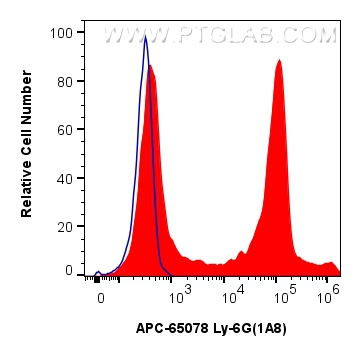验证数据展示
经过测试的应用
| Positive FC detected in | mouse bone marrow cells |
推荐稀释比
| 应用 | 推荐稀释比 |
|---|---|
| This reagent has been tested for flow cytometric analysis. It is recommended that this reagent should be titrated in each testing system to obtain optimal results. | |
| Sample-dependent, Check data in validation data gallery. | |
产品信息
APC-65078 targets Ly-6G in FC applications and shows reactivity with mouse samples.
| 经测试应用 | FC Application Description |
| 经测试反应性 | mouse |
| 免疫原 | Ly-6G transfected EL-4J cell line 种属同源性预测 |
| 宿主/亚型 | Rat / IgG2a, kappa |
| 抗体类别 | Monoclonal |
| 产品类型 | Antibody |
| 全称 | lymphocyte antigen 6 complex, locus G |
| 别名 | Ly6g, Ly-6G.1, Ly 6G, 1A8 |
| GenBank蛋白编号 | X70920 |
| 基因名称 | Ly-6G |
| Gene ID (NCBI) | 546644 |
| RRID | AB_2882977 |
| 偶联类型 | APC Fluorescent Dye |
| 最大激发/发射波长 | 650 nm / 660 nm |
| 形式 | Liquid |
| 纯化方式 | Affinity purification |
| UNIPROT ID | P35461 |
| 储存缓冲液 | PBS with 0.09% sodium azide and 0.1% gelatin , pH 7.2 |
| 储存条件 | Store at 2-8°C. Avoid exposure to light. Stable for one year after shipment. |
背景介绍
Ly-6G (lymphocyte antigen 6 complex, locus G), also known as Gr-1, is a 21-25 kDa, glycosylphosphatidylinositol-anchored protein expressed on myeloid lineage cells in mouse bone marrow (PMID: 8360469). The expression of Ly-6G increases on neutrophils as they differentiate from immature cells in the bone marrow to mature cells in the blood and spleen (PMID: 8890901). Antibodies targeting Ly6G (RB6-8C5 or 1A8) are commonly used in studies aimed at identifying the role of neutrophils (PMID: 23543767). The 1A8 mAb is specific for Ly-6G (PMID: 8360469).
实验方案
| Product Specific Protocols | |
|---|---|
| FC protocol for APC Ly-6G antibody APC-65078 | Download protocol |
| Standard Protocols | |
|---|---|
| Click here to view our Standard Protocols |
